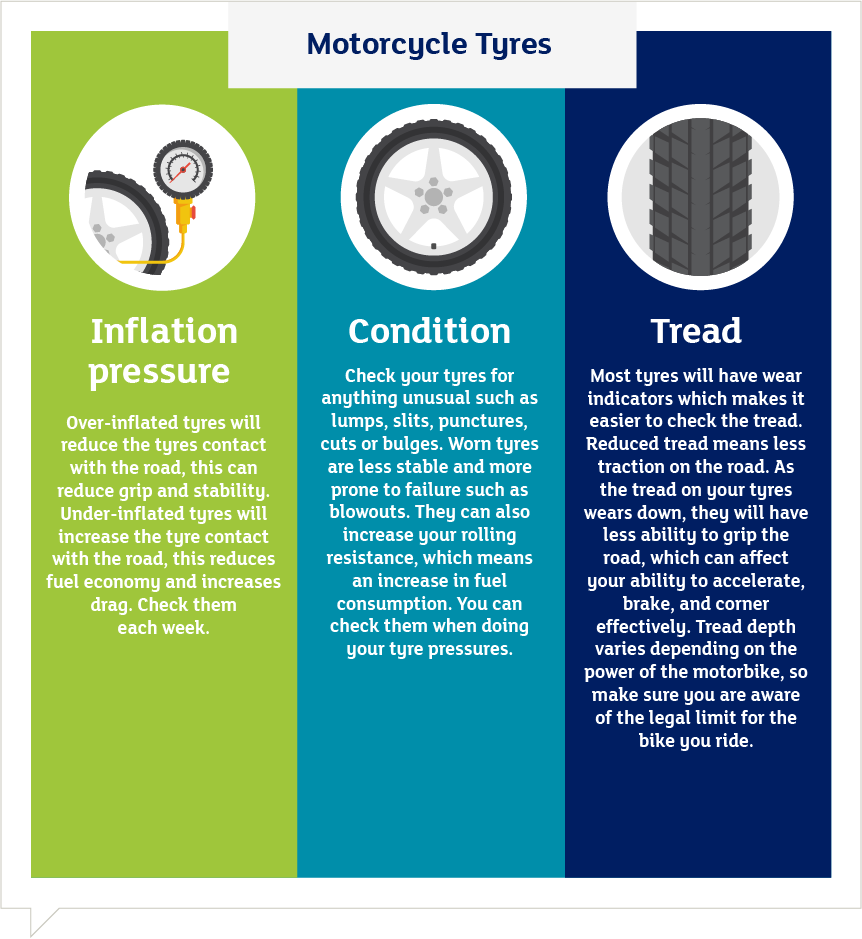 Prepare your Bike
Prepare your Bike
When buying a motorcycle, make sure that it is suitable for you and that your licence entitlement covers the power output of it. Regular maintenance will help to keep you safer and help to keep your bike in good working order.
How can I make sure my motorbike is in good working order?
It’s important to check your bike regularly to ensure it is ready and prepared for the ride ahead. By doing some simple checks, you can help to lengthen the life of the bikes components and make sure it is roadworthy and is safe to be ridden on the road. Many of these are simple checks that you can perform yourself. Some of these checks should be completed before every ride, while others will need to be performed less often.
What are the POWDER checks?
We recommend making sure that your bike is roadworthy by carrying out POWDER checks. You can carry these out every time you ride, or at least every few days if you ride every day. If you haven’t ridden your bike for a few days or you are planning a longer trip then you should definitely run through these checks before setting out. For more information about POWDER checks you can watch a RoSPA video on them here.
-
Petrol: make sure you have sufficient fuel or charge for your journey
-
Oil: check your engine oil and brake fluid levels, and make sure everything that needs to be lubricated is, including all levers, cables and the chain. You should also check for oil leaks
You don’t need to check the engine oil every time you go out on a ride, but we recommend checking it at least once a week. Having the right amount of oil in your bike ensures that it continues to run smoothly. Checking it is easy and can be done by using the dipstick or looking through the sight glass. This needs to be done when the bike is cold. If the oil level is low, top it up using the recommended oil in your manual
-
Damage: ensure that your bike is damage-free and in good condition. Is any of the bike scuffed? Are the mirrors and light lenses in tact? Is there any liquid pooling under the bike?
-
Electrics: check your lights, indicators, the dashboard and the horn
Are all the lights working properly? Does your horn make a sound? Make sure the front, rear, indicators and hazard lights all work. Make sure that the lights and the reflectors can be seen clearly and are free from mud and dirt.
How do I check my tyres?
Check the tread – the legal limit of tyre tread depth in the UK for motorcycles over 50cc is 1mm across ¾ of the width of the tread pattern and with visible tread on the remaining ¼. For motorcycles up to 50cc, the law requires that all the grooves of the original tread pattern must be clearly visible. Most tyres will have wear indicators, which will be exposed when the tread is worn down. If they are worn, replace them at the next opportunity.
Check their general condition – make sure that the tyres have not got any lumps, slits, punctures, cuts or bulges.

Why do I need to check on my tyres each week?
It can be more difficult to tell if the tyre pressures on a motorbike are too low, due to the tyres being stiffer than a car tyre. Over-inflated tyres will reduce the tyres contact with the road, this can reduce grip and stability. Under-inflated tyres will increase the tyre contact with the road, this reduces fuel economy and increases drag.
Several factors can affect the tyre pressure so it’s important to check them each week using an accurate gauge or machine at a fuel station. Your manual will advise you of the appropriate pressures for each tyre. Remember, the manufacturer may recommend different pressures for the front and rear tyres.
What could happen if my tyre is faulty or worn?
If your tyre is not in good condition it can negatively affect the bikes handling and stability and could result in tyre failure. Specific problems include:
-
Reduced traction: As the tread on your tyres wears down, they will have less ability to grip the road, which can affect your ability to accelerate, brake, and corner effectively
-
Decreased stability: Worn tyres may also have less stability, which can make your motorcycle feel less predictable and harder to control
-
Increased risk of a blowout: Worn tyres are more prone to failure, such as a blowout, which can be dangerous at high speeds
-
Decreased fuel efficiency: Worn tyres may also have increased rolling resistance, which can reduce fuel efficiency and increase fuel consumption.
If you’re caught using faulty or worn tyres you could be fined up to £2,500, disqualified from riding or receive points on your licence for each faulty tyre.
How often do I need to check my chain?
Generally it is expected that you check your chain every 500 miles. We recommend that you check for tension, alignment, wear, cleanliness and how lubricated it is. If you neglect your chain then it can result in a damaging your bike, or it can rust and possibly break.
Tension and alignment: You can check your chain and make adjustments to its tension and alignment yourself. There are many videos on the internet like this one that can show you how to check it and how to make adjustments.
Cleanliness and Lubrication: Give it a good clean using a brush or a cloth; specialist motorbike chain cleaner will make the job easier. After cleaning, you will then need to lubricate your chain.
How often does my motorbike need an MOT?
Your motorbike does not require an MOT until it is three years old. Once your bike is three years old or older it will need to pass an MOT every year to be legally allowed on the road. You will find up to date information on MOTs on the Government website.
How often do I need to service my bike?
It is best to refer to the owners manual to find the recommended service frequency. Typically, a motorbike will need to be serviced every six months or between 2500-4000miles.
What is a major motorbike service?
This is a comprehensive service that involves a thorough inspection and servicing of the various components and systems of a motorbike. It is important to follow the manufacturer's recommended service intervals to ensure that your motorcycle is running at its best and to identify and address any potential issues before they become serious problems. What is included in a full service can vary but should include:
Engine checks
Chassis & brake checks
-
Brake callipers removed and cleaned
-
Brake pistons degreased
-
Hydraulic Brake Fluid System inspected, topped up or replaced as required
-
Control cables, levers and pivots (throttle, clutch, brakes) cleaned and lubricated
-
Adjustment of throttle and clutch
-
Battery electrolyte level checked and topped up as required
-
Steering play and race bearing kit examined for any looseness and adjusted as necessary
-
Front fork inspected and checked for operation
-
Rear suspension inspected and checked for operation
-
All fasteners – including engine mounting and chassis bolts inspected and tightened as required
-
Wheel bearings checked
-
Main and side stands checked and lubricated
-
Headlight checked for aim and focus and adjusted as required
-
Fuel hose checked
-
Tyre pressures checked and adjusted as necessary
-
Chain adjusted and lubricated as necessary
-
General lubrication.